Bulletin – December 2016 Australian Economy Measures of Inflation Expectations in Australia
- Download 464KB
Abstract
Inflation expectations have an important influence on wage growth and price inflation. Expectations differ across agents and time and, accordingly, the Reserve Bank monitors a range of measures. This article discusses why inflation expectations are important for inflation and economic activity, the measures that exist in Australia and various issues affecting their interpretation. The financial markets that are used to calculate some measures of inflation expectations are not particularly liquid in Australia, and the financial measures also include an inflation risk premium; these issues can affect the interpretation of movements in the series.
Introduction
Inflation expectations are important for a number of reasons. First, inflation expectations influence decisions such as wage negotiations or price setting, which typically occur infrequently.[1] As a result, inflation expectations have a self-referential component: if firms expect inflation to be low, they will set their prices accordingly, creating low actual inflation. This has implications for the ease with which the Reserve Bank of Australia (RBA) can achieve its inflation target.
Second, changes in both short- and long-term inflation expectations affect real interest rates (the difference between nominal interest rates and inflation expectations) and hence the stance of monetary policy. If inflation expectations decline, real interest rates become less accommodative if nominal interest rates are unchanged. In theory, higher real interest rates provide an incentive for households to consume less. This is because higher real rates make the return on savings more attractive and discourage firms from investing by raising borrowing costs.
Finally, longer-term measures of expectations – particularly those that abstract from near-term inflation – might be informative about the credibility of the central bank's ability to achieve its inflation target. Large deviations in these measures from the inflation target could suggest that long-term inflation expectations have become unanchored, which makes it more difficult for monetary policy to stabilise inflation and output.
Given their importance, the RBA monitors a range of measures of inflation expectations (Graph 1). These measures have come under increased focus lately, as low inflation outcomes over the past year or so have been associated with declines in shorter-term measures of inflation expectations. Over the same period, financial market-based measures of long-term inflation expectations have also moved lower, but survey-based measures of long-term inflation expectations have moved by less. These developments have raised questions about how to measure inflation expectations, what they mean for understanding future inflation outcomes, and how to interpret movements in the market-based measures in particular. This article surveys the various measures of inflation expectations in Australia and discusses the issues that surround several of these measures. In particular, using a newly available transaction-level database on activity in the inflation swaps market, the article explores some challenges in interpreting market-based measures of inflation expectations.
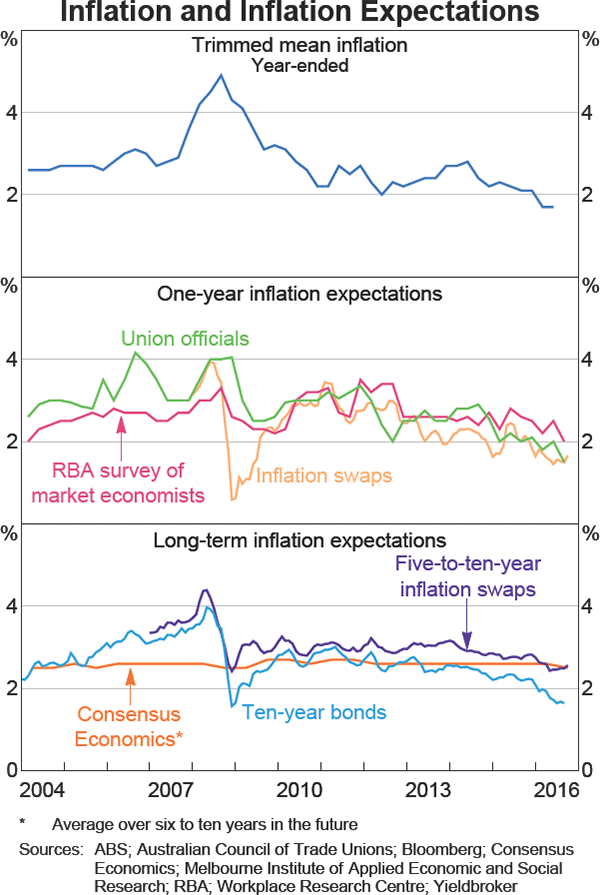
Measures of Inflation Expectations
There are three broad types of commonly used measures of inflation expectations in Australia: surveys of professional forecasters; surveys of consumers and firms; and market-based measures.
Surveys of professional forecasters
There are three key surveys of professional forecasters: the quarterly RBA survey of market economists; Consensus Economics' monthly survey; and the quarterly survey of union officials. All of these surveys ask for expectations for headline inflation, although questions for trimmed mean inflation were recently added to the RBA survey. The RBA and union surveys both ask participants for forecasts of year-ended inflation for the June and December quarters for the next two years. This permits the construction of one- and two-year expectations for year-ended inflation. In contrast, Consensus Economics asks for year-average inflation for the current calendar year and the next calendar year, which means that the survey horizon changes through the year: in January, forecasters are forecasting inflation one year ahead, but by December they are forecasting just one month ahead.[2] The RBA survey is run shortly after the release of the Consumer Price Index (CPI) and the results are published in the Reserve Bank's Statement on Monetary Policy a few weeks later.
The RBA also monitors surveys of longer-term expectations. The first is from the survey of union officials. It asks for expectations for medium-term inflation, defined as average annual inflation over the next five to ten years. An identical question was added to the RBA survey of market economists in mid 2015. The second is from Consensus Economics, which captures expectations of average inflation for between six and ten years. Because it abstracts from near-term influences on inflation, the measure is ideal for assessing anchoring of long-term inflation expectations. The drawback of the Consensus long-term measure is that the survey question is included only twice a year (in April and October).
Graph 2 suggests that the introduction of inflation targeting in 1993 established a strong anchor around 2½ per cent, although long-term expectations did not reach 2½ per cent until late 1998; given the previous experience with high inflation, this five-year lag is unsurprising and was expected at the time (Fraser 1994). Recently, all the survey measures have declined to around the levels seen in the late 1990s.
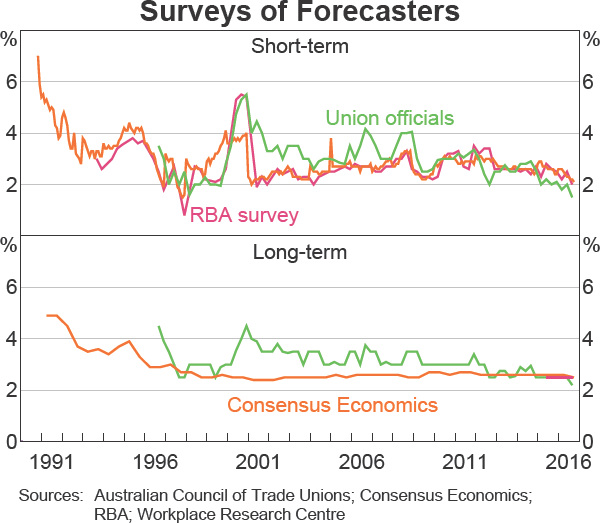
Low inflation expectations are consistent with low wage and consumer price inflation outcomes and the RBA's expectation that inflation will only return to more normal levels gradually.
There are two key advantages to these types of measures. First, because survey respondents are professional forecasters, respondents are well informed and invest substantial resources into forming their expectations for inflation. Second, the measures have long and consistent time series, which is useful for econometric modelling and permits examination of how the measures respond to past events. The main drawback of these measures is that, as theory tells us, it is the expectations of decision-makers in the economy – firms and households – whose expectations matter for wage and price setting decisions. There is little reason to believe that the relatively small number of survey respondents (typically 15–20) is representative of the broader population. This may be less of an issue with the union survey, since these officials may be involved in wage negotiations on behalf of a large number of their members.
Surveys of consumers and firms
The Melbourne Institute measure of inflation expectations is based on a survey of around 1,200 consumers run every month. Consumers are asked how they expect the ‘prices of the things you buy’ to change over the next year (Graph 3). The responses are weighted to ensure that the survey sample matches population characteristics for gender, age and location. In theory, consumers' inflation expectation should be highly relevant for inflation dynamics, since consumers are key decision-makers in the economy. In practice, research suggests that consumers' expectations do not line up well with actual inflation outcomes. Responses tend to be clustered around round numbers such as 5 or 10 per cent and overly responsive to movements in certain salient prices, such as petrol (Brischetto and de Brouwer 1999; Ballantyne, et al 2016). These problems make interpreting movements in the measure more difficult.
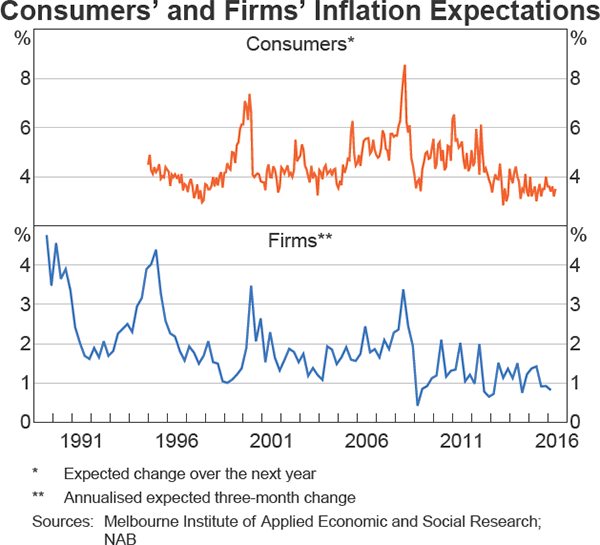
A survey of firms' inflation expectations with a long history is the National Australia Bank's survey of inflation expectations, which asks firms how they expect the price of their final goods to evolve over the next three months (Graph 3).[3] Much like the consumer survey measure, in theory these measures should be highly relevant – firms' expectations are what should feed in to price- and wage-setting decisions. However, as with the consumers' expectations measure, research has typically found that firms' expectations do not line up well with actual inflation outcomes.
Market-based measures
There are two market-based measures of inflation expectations in Australia. The first is the fixed rate on inflation swaps, which are a type of over-the-counter (OTC) derivative. In an inflation swap, one party receives a payment indexed to inflation in exchange for a payment determined by a fixed rate, which is agreed on at initiation of the contract. Users of inflation swaps include pension funds (who use them to hedge long-dated inflation-linked obligations) and infrastructure project providers (who use them to hedge their inflation-linked assets or revenues). The second market-based measure of inflation expectations is derived from the difference in yields between nominal and inflation-indexed Australian Government Securities (AGS).[4] Because their face value is indexed to the CPI, the yield on inflation-indexed bonds is a real yield. Thus, the difference between the nominal and inflation-indexed AGS is the average rate of inflation over the next 10 years that equates the expected return on nominal AGS to the expected return on inflation-indexed AGS; this is often referred to as the ‘break-even’ inflation rate.
These measures are useful for a number of reasons. First, market participants have substantial financial resources at stake. This means that they have strong and direct incentives to form accurate expectations for inflation and, as a result, are likely to be well informed. Second, the inflation-indexed bond measure has a long time series, with monthly data from 1985 and daily data from 1993. This makes it well suited for econometric modelling. Third, for inflation swaps, prices are available at many tenors, which permits the construction of a ‘term structure’ of inflation expectations – for instance expected inflation between five and ten years into the future (Graph 4). These types of forward measures are a good way to assess longer-term anchoring of expectations because they abstract from temporary factors.
There are a few characteristics of these markets that may cloud the interpretation of both the level and the movements in inflation expectations.[5] The first is that, in Australia, markets for these instruments are not particularly active or liquid. For inflation-linked bonds, liquidity is low relative to nominal AGS and so investors who wish to hold highly liquid assets will have a preference for nominal AGS. As a result, investors may demand a higher yield on inflation-linked AGS, known as a ‘liquidity premium’, to compensate for the risk of market prices moving against the investor in a substantial way if they try to sell their position. This liquidity premium may downwardly bias the bond-based measure of inflation expectations. As derivatives, the supply of inflation swaps is not constrained, meaning that, in theory, inflation swap rates should be less affected by liquidity preference effects (Finlay and Olivan 2012). However, inflation swaps may be narrowly provided (due to balance sheet constraints) and reflect the views of just a small number of market makers. As outlined below, this is the case in Australia. This means that the inflation swaps measure of inflation expectations is not particularly representative. In which direction these concerns should bias the swaps measure of inflation expectations is unclear – it depends on which side of the transaction the market maker is on. Further work could try to assess and measure this bias.
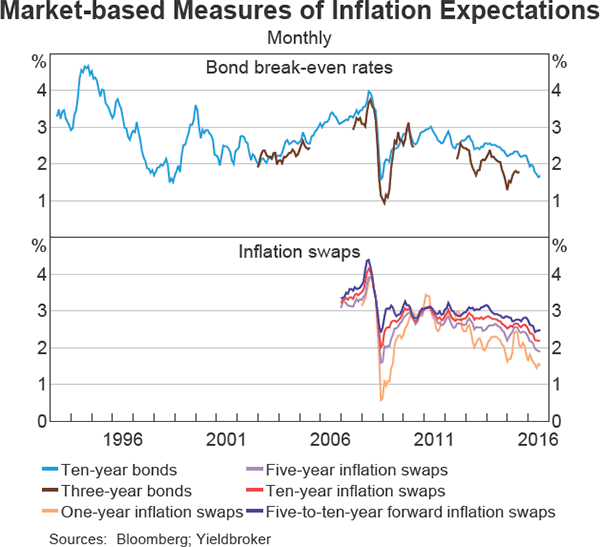
The second concern is that these measures are compensation for bearing inflation risk. In addition to expectations, both market-based measures contain an inflation risk premium. This premium is the additional yield that investors demand to compensate for the risk of lower- or higher-than-expected inflation. The inflation risk premium means that the market-based measures of inflation expectations are biased upwards.
Moreover, there is evidence that the inflation risk premium varies over time.[6] This makes it difficult to interpret movements in the market-based measures, because movements could be either due to changes in expectations or changes to the inflation risk premium. Finlay and Wende (2011) use a structural model that incorporates data from inflation-linked AGS and the Consensus Economics survey of long-term inflation expectations to try to disentangle inflation expectations from the inflation risk premium.[7] They find that, at the one-year horizon, the two vary by similar magnitudes. At longer horizons, Finlay and Wende find much of the variation in the break-even inflation rate is due to changes in the inflation risk premium (Graph 5). Other estimates in the overseas literature differ in how much variation they attribute to the expectations versus the inflation risk premium, and the estimates can be sensitive to model specification. Nonetheless, much of the literature finds sizeable variation in the inflation risk premium. Estimates similar to Finlay and Wende's have not been done using inflation swaps data in Australia.
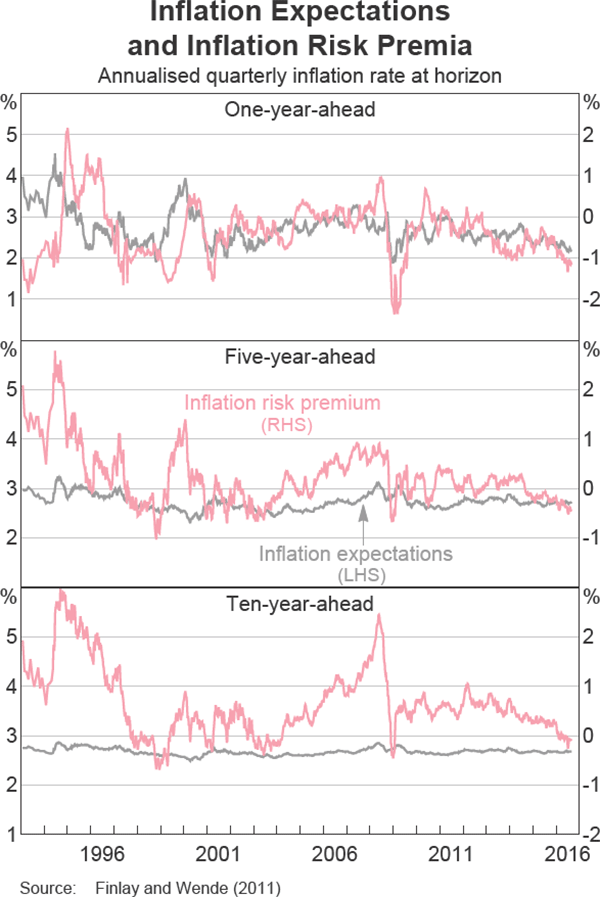
A Closer Look at the Effect of Liquidity and Activity on the Market-based Measures
Inflation-linked bonds
Various metrics suggest that liquidity is substantially lower for inflation-linked AGS than for nominal AGS (Graph 6). It is for this reason that the yields on inflation-linked AGS are believed to embed a liquidity premium over nominal AGS. If the liquidity premium were constant over time, it would affect only the level of the estimated bond break-even inflation rate. However, there is a steadily increasing wedge between the 10-year inflation swaps rate and 10-year bond break-even rates since about 2011 (Graph 7).
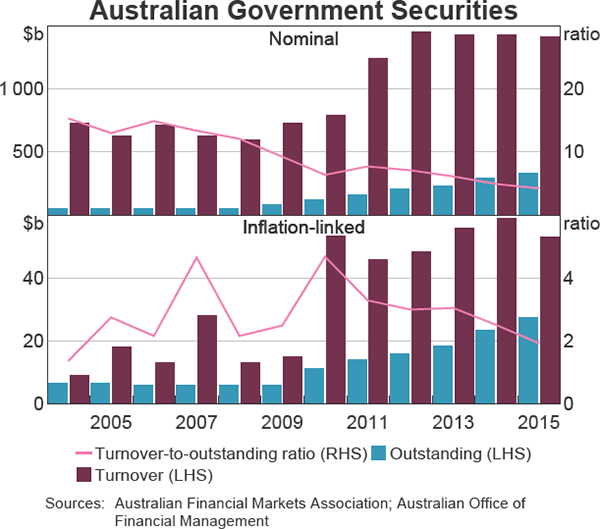
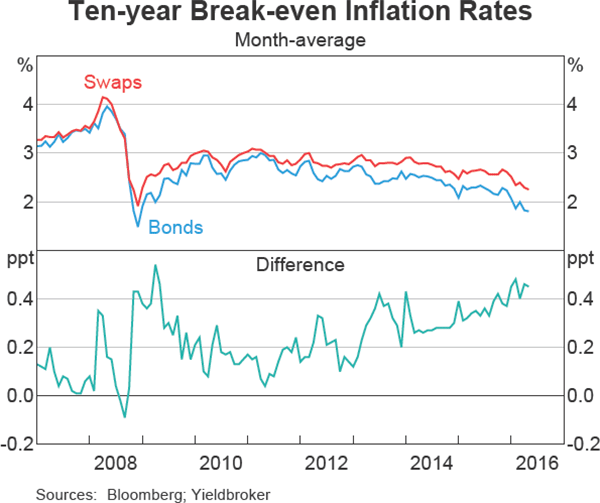
The widening in the spread between the two rates might be the result of changes to either market. One possibility is that the liquidity premium in inflation-linked AGS has risen, exacerbating the downward bias in the bond-based measure of inflation expectations. This would be consistent with the widespread view that liquidity in global bond markets has declined noticeably since 2008 (e.g. Levine 2015; Debelle 2015; CGFS 2016). In Australia, the decline in fixed income market liquidity has been less pronounced than globally; nonetheless, there is some evidence that bond markets are less liquid than in the past, but that an increase in interest rate derivatives market liquidity has more than offset this (Cheshire 2016). This change reflects, at least in part, a correction in the pricing of liquidity, which had been ‘underpriced in the years prior to the global financial crisis’ (Debelle 2016). These developments may have raised the liquidity premium inherent in inflation-indexed AGS by more than in nominal AGS because of the lower initial liquidity in inflation-linked AGS. If this is the case, the bond-based measure of inflation expectations may have become more downwardly biased than in the past.
Inflation swaps
In theory, inflation swaps may be less affected by a liquidity premium than inflation-linked bonds; as long as a willing counterparty can be found, the swap can be created. Similarly, unlike purchasing government securities, inflation swaps involve no exchange of funds at the initiation of the contract. Despite being off-balance sheet, swaps nonetheless carry capital and leverage implications for prudential regulatory purposes. This means that balance sheet space still represents a constraint on liquidity in this market. Recent regulatory reforms, such as the Basel III leverage ratio, have made OTC derivatives (including inflation swaps) more expensive for banks (see Heath and Manning (2012) for more detail).[8] These developments are likely to have reduced liquidity in the inflation swaps market. However, it is unclear how this should affect inflation swaps rates – whether it should raise or lower the rate depends on which side of the swap the bank is on.
The main liquidity-related concern with inflation swaps is that the market is not particularly active and so prices are not broadly representative and are not always based on actual transactions. Because it is an OTC market, market liaison and the annual survey run by the Australian Financial Markets Association have previously provided the only data on market activity. Transaction-level data for OTC derivatives have recently become available as part of reforms to OTC derivatives markets, which require all transactions to be reported to a centralised repository.
These data indicate that market activity is low, with an average of just 21 transactions per week over the first half of 2016 (Graph 8). Even at the most liquid tenor (10 years), there was an average of about six transactions per week. As a result, individual transactions may have greater price impact than would transactions in deeper, more liquid markets; similarly, many of the daily observations are not based on actual transactions and instead reflect quotes provided to Bloomberg by market makers. These factors suggest that daily changes in inflation swaps rates should be interpreted with caution; longer-term averages (such as monthly averages, which the RBA typically uses for inflation swaps) are likely to mitigate these factors.
These data also indicate that the inflation swaps market is dominated by a few large market makers (Graph 9).[9] Reflecting this concentration, activity is largely between institutions typically thought of as dealers.[10] Graph 10 classifies transactions according to the types of counterparties to the transaction.[11] Transactions between these dealers account for 70 per cent of all transactions, split as: 8 per cent between two domestic banks; 35 per cent between a domestic bank and an international investment bank; and 27 per cent between two international banks. These observations suggest that some caution is warranted when interpreting the inflation swaps measure because pricing is based on just a few participants and transactions, and may not be representative of broader inflation expectations. Whether this concentration of activity biases the inflation swaps measure of inflation expectations is unclear; further work could look into this issue.
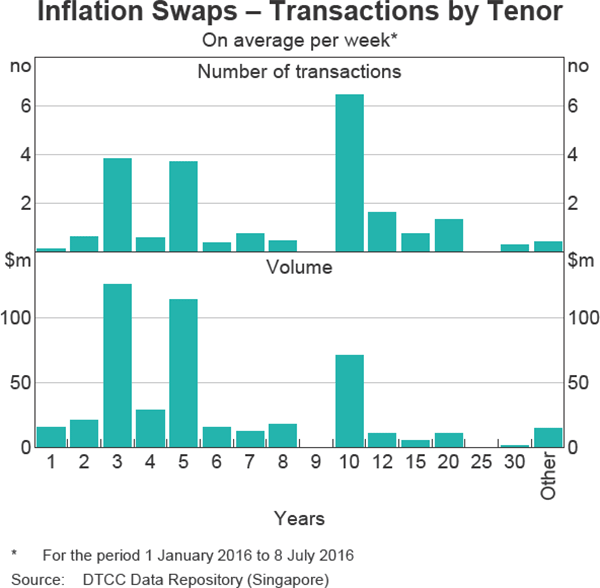
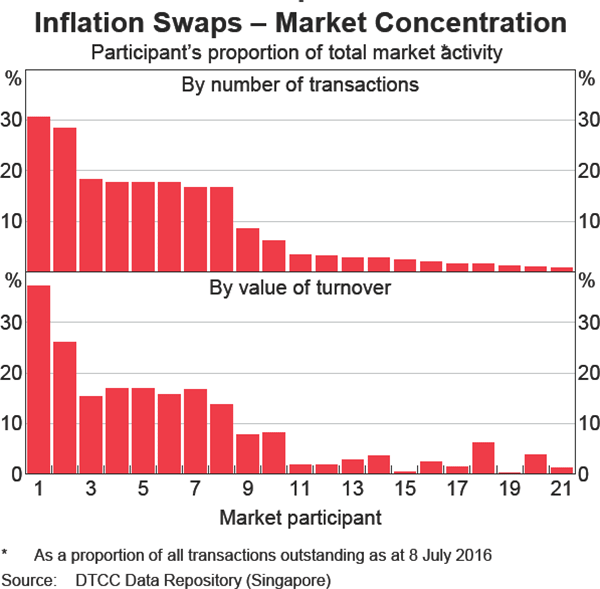
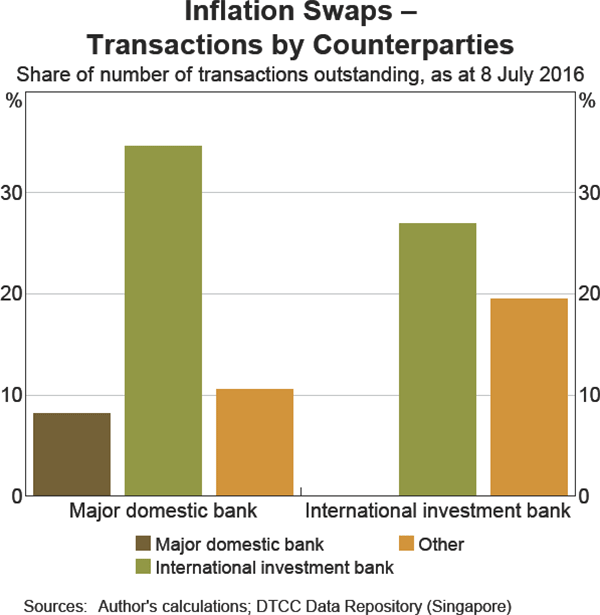
Investment and super funds are the largest ‘end users’ of inflation swaps, together accounting for about 17 per cent of transactions.[12] These funds mostly transact with international investment banks, rather than major domestic banks. All of these findings are consistent with prior market liaison, which suggests that the main end users of inflation swaps are hedgers with long-dated inflation-linked obligations (such as super funds) or corporates who issue inflation-linked debt (Finlay and Olivan 2012).
Conclusion
There are a number of measures of inflation expectations, which include surveys of professional forecasters, households and firms, as well as financial market-based measures. All of these measures have various issues affecting their interpretation and so the RBA monitors all of them.
More recently, market-based measures of longer-term inflation expectations have moved lower than survey-based measures of longer-term expectations. Some of the variation in the market-based measures appears to be due to changes in the inflation risk premium. Also, the bond-based measure is likely to have been affected by a time-varying liquidity premium. Whether recent regulatory developments or the low level of activity in the inflation swaps market bias inflation swaps rates is not yet clear; further work could look into this issue.
Taking these observations together, long-term inflation expectations appear consistent with the RBA's medium-term inflation target. Nonetheless the low level of shorter-term measures requires ongoing monitoring, particularly if this were to become entrenched in longer-term measures. Previous generations of the RBA's inflation forecasting models have relied on the bond-based measure of inflation expectations (Gruen, Pagan and Thompson 1999; Norman and Richards 2010). One implication of this article is that alternative measures should be considered when incorporating inflation expectations into these types of models.
Footnotes
The author is from Economic Analysis Department. [*]
Estimates for Australia suggest prices are reset, on average, once every three quarters (Jääskelä and Nimark 2011). Similarly, evidence from the RBA's liaison with firms found that a majority of firms reset prices once per year (Park, Rayner and D'Arcy 2010). [1]
Consensus Economics also runs a quarterly survey that asks for year-ended growth for each of the quarters in the current and next calendar years.Unlike the monthly survey, Consensus Economics provides only the mean of the survey responses rather than all of the individual responses. [2]
Two other surveys of firms – the ACCI-Westpac and Dun & Bradstreet surveys – also ask firms about their expectations for their final prices. However, these surveys only ask for whether firms expect their prices to increase, decrease or stay the same. [3]
Additional adjustments are also required to account for other factors such as the different coupon frequencies of nominal and inflation-indexed AGS and different maturities of the bonds. Finlay and Olivan (2012) discuss these issues. [4]
An additional concern with the bond-based measure is that there are relatively few inflation-linked AGS on issue. This means that the ‘10-year’ rate is really an interpolated approximation, based on bonds with other maturities. This scarcity also means that it is difficult to reliably construct expectations other than 10-year. In the past, the RBA has constructed a three-year break-even rate; however, coverage is patchy because appropriate maturity bonds are not always available. [5]
This evidence is part of a long literature documenting the existence of time-varying risk premia in assets of all types (Shiller 1981; Fama and French 1988). There is some evidence in favour of the existence of time-varying risk in inflation swaps in Australia; however, because of the short time series available for swaps, this evidence is weak. Overseas research has found that time-varying risk premia are present in the yields on inflation-linked bonds and inflation swaps in other countries (Evans 1998). [6]
I thank Jonathan Hambur for his work extending these estimates to 2016. [7]
Other reforms, such as capital requirements for uncleared OTC derivatives and initial margin requirements for non-centrally cleared OTC derivatives, are also relevant. Australian dollar inflation swaps are not currently accepted for central clearing at SwapClear (the dominant central counterparty for OTC derivatives in Australia), so reforms requiring mandatory central clearing are unlikely to be relevant for inflation swaps at present. [8]
These numbers are not exclusive: a transaction between the two parties would be counted twice (since there are two sides to every transaction). [9]
Dealers have been classified in two groups: the five major domestic banks; and the eight most active international investment banks (and two subsidiaries). [10]
The bars sum to (almost) 100 per cent. The remaining transactions do not have a major domestic bank or international investment bank as at least one of the counterparties. This is a tiny fraction of transactions. The right-hand side of the graph does not include a ‘Major domestic bank’ series because doing so would double count those transactions. [11]
Investment funds may be acting on behalf of other end users (such as super funds), but the database does not provide sufficient information to test this hypothesis. [12]
References
Ballantyne A, C Gillitzer, D Jacobs and E Rankin (2016), ‘Disagreement about Inflation Expectations’, RBA Research Discussion Paper No 2016-02.
Brischetto A and G de Brouwer (1999), ‘Householders' Inflation Expectations’, RBA Research Discussion Paper No 1999-03.
CGFS (Committee on the Global Financial System) (2016), ‘Fixed Income Market Liquidity,’ CGFS Papers No 55, Bank for International Settlements, Basel.
Cheshire J (2016), ‘Liquidity in Fixed Income Markets’, RBA Bulletin, June, pp 49–58.
Debelle G (2015), ‘Bond Market Liquidity, Long-term Rates and China’, Speech at the Actuaries Institute ‘Banking on Change’ Seminar, Sydney, 16 September.
Debelle G (2016), ‘Liquidity in Australian Fixed Income Markets’, Address to the 4th Australian Regulatory Summit, Sydney, 21 June.
Evans M (1998), ‘Real Rates, Expected Inflation, and Inflation Risk Premia’, Journal of Finance, 53(1), pp 187–218.
Fama E and K French (1988), ‘Dividend Yields and Expected Stock Returns’, Journal of Financial Economics, 22, pp 3–25.
Finlay R and D Olivan (2012), ‘Extracting Information from Financial Market Instruments’, RBA Bulletin, March, pp 45–54.
Finlay R and S Wende (2011), ‘Estimating Inflation with a Limited Number of Inflation-indexed Bonds’, RBA Research Discussion Paper No 2011-01.
Fraser B (1994), ‘The Art of Monetary Policy’, Talk to the 23rd Conference of Economists , Surfers Paradise, 26 September.
Gruen D, A Pagan and C Thompson (1999), ‘The Phillips Curve in Australia’, Journal of Monetary Economics, 44(2), pp 223–258.
Heath A and M Manning (2012), ‘Financial Regulation and Australian Dollar Liquid Assets’, RBA Bulletin, September, pp 43–52.
Jääskelä J and K Nimark (2011), ‘A Medium-Scale New Keynesian Open Economy Model of Australia’, Economic Record, 87(276), pp 11–36.
Levine M (2015), ‘A Tale of Two Liquidities’, Bloomberg View, 26 August, viewed 21 October 2016. Available at <https://www.bloomberg.com/view/articles/2015-08-26/it-was-the-worst-of-ideas>.
Norman D and A Richards (2010), ‘Modelling Inflation in Australia’, RBA Research Discussion Paper No 2010-03.
Park A, V Rayner and P D’Arcy (2010), ‘Price-setting Behaviour – Insights from Australian Firms’, RBA Bulletin, June, pp 7–14.
Shiller R (1981), ‘Do Stock Prices Move Too Much to be Justified by Subsequent Changes in Dividends?’, American Economic Review, 71(3), pp 421–436.